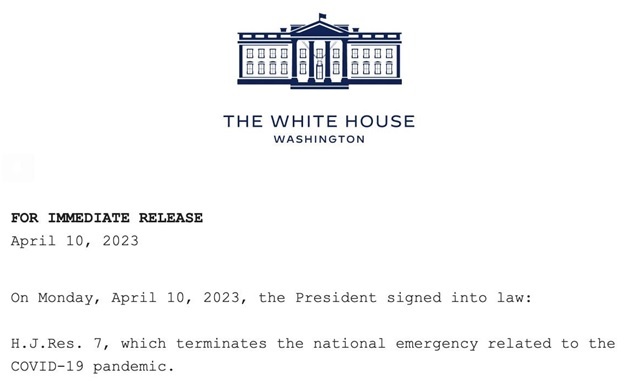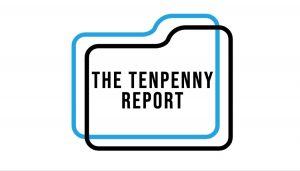After three years, the “emergency use authorization” has finally ended. But, wait. Not so fast.
On Easter Monday, on the same day the Biden Administration announced a new $5 billion plan to aid pharmaceutical companies in developing new COVID vaccines, Joey B. took a “significant and symbolic” step toward a POST Pandemic World, signing on H.J.Res 7, ending the three-year-long National COVID-19 “state of emergency.”
The resolution passed the House despite almost 200 Democrats voting against it. The White House originally expressed opposition to ending the COVID-19 emergency.

“Is there a catch?” I immediately wondered. Why now? Did Robert F. Kennedy Jr.’s presidential announcement have something to do with it? Was the jig finally up? Was it because there is another emergency on the horizon?
Upon combing through the Ministry of Truth’s gobblygook, I got a headache. I usually can synthesize dense content, but I was very bewildered because the government sites seemed to say that the emergency was over, but not really. In other words, it looks like the official emergency is over but the deadly EUA lives on. In fact, the FDA is poised to approve a seventh dose of the COVID mRNA vaccine by emergency use authorization. (It may not have worked after six doses, but seven is a lucky charm.)
During my research, I asked Ryan Cristian of The Last American Vagabond if he had covered the topic, given his thorough reporting. He agreed it was designed to practically be impossible to understand. I have to admit, I was relieved to learn he was also confused and that it wasn’t a cognitive fart on my part.
“There is a lot of confusion about the EUA because there are actually a few different emergency declarations,” agrees Dani Lasher, President of Informed Choice Maryland.
The EUA was published in March 2020 based on an emergency declaration issued a month prior in accordance with the Federal Food, Drug, and Cosmetic (FD&C) Act.
“To my knowledge, that emergency declaration is independent of Biden’s emergency declaration and does not end just because Biden’s does, nor does the Public Health Emergency (PHE) first declared in January 2020 by the Secretary of Health & Human Services (HHS). That declaration is slated to expire in May,” says Lasher.
She is referencing HHS’s March 13, 2023 announcement that declared the COVID-19 public health emergency (PHE) under the Public Health Service (PHS) Act will expire on May 11, 2023.
An EUA declaration is distinct from and not dependent on a PHE declaration under section 319 of the PHS Act, and therefore EUA may remain in effect beyond the duration of the section 319 PHE declaration if all other statutory conditions are met.
Said in a different way, the PHE declared by HHS under the PHS Act will not impact the FDA’s ability to authorize devices, which includes tests, treatments, or vaccines for emergency use. Furthermore, existing emergency use authorizations (EUAs) for products will remain in effect and the agency may continue to issue new EUAs going forward when the criteria for issuance are met.
So if you are still following, the GOP bill to end the emergency does not truly end it. Seemingly there are several emergencies and several state emergency responses that have expiration dates that are not tied to the end of the federal emergency declarations.
Waivers will still be issued and EUA products will seemingly remain for eternity in violation of known federal law.
EUA Memory Lane
Before I attempt to parse the mind-bending Double Speak, I need to give you a little refresher on Emergency Use Authorization (EUA). First off, it’s really a humongous loophole to accelerate Big Pharma products that have not been fully vetted for (real) “safety.”

The official explanation is that EUA allows the use of medical products, such as vaccines and therapeutics, during public health emergencies, including pandemics, before they are fully approved by the FDA.
“Quick there’s a fire.” Oh wait, it’s a false fire. But quick, it’s still an emergency.
The EUA authority allows the FDA, based on the evaluation of available data, to authorize the use of unapproved or uncleared medical products following a determination and declaration of emergency, provided certain criteria are met. The authorization ends when the declaration of emergency is terminated or the authorization is revoked by the agency.
So basically, EUA products are NOT held to the same standards. It’s “FDA issued” vs “FDA approved.” This is a crucial distinction.
Meanwhile, the biggest audacity of the EUA is that it was all predicted upon “no adequate, approved, and available alternatives.”
What a crock.
The reality is that there were/are so many alternatives beyond ivermectin and hydroxychloroquine (HCQ) that are, after all, considered allopathic alternatives. Incidentally, HCQ was taken off of the EUA list.
Consider that in March 2020, the Food and Drug Administration launched Operation Quack Hack to go after hundreds of people, including Alex Jones, Mark Grenon of Genesis Church, and myself, who stand for natural immunity and natural remedies. In my case, they came after my company HoneyColony for our super-chelated 4,000 ppm silver and selling Vitamin C. oh yah, and for using the word ‘preventative.’ Health Ranger aka Mike Adams had to help me break this story since I am a poster child for what is now being referred to as the “Censorship Industrial Complex.”
To put things in perspective, prior to the Rona Regime, there were, on average, about 100 products approved annually under EUA. During the last pandemic – H1N1 in 2009– only 17 EUA products were approved for the year. But then, in 2020, EUA was exploited up the wazoo — suddenly there were 100+ applications each month, and more than 320 EUAs were doled out for the year. Many were crappy.
Remember, for instance, the infamous PCR RT non-test test? When I started covering this plandemic in early January 2020, there was ONE test under EUA. It was a CDC test. In weeks, one test approval turned into six and then 13. Can someone say cottage industry?
Many of us tried to hammer that the “test” was unreliable and should never have been used for diagnostic purposes. Inventor Kary Mullis said it wasn’t a diagnostic tool, but he conveniently died in August 2019 so he could not speak up.
PCR tests are unreliable due to the amplification threshold. Anything over 28-30 cycles will create an abundance of false positives. In the USA, the cycle threshold was said to be 35 cycles. The WHO recommended 40 to 45 cycles. So they varied. High amplifications can pick up the presence of any virus. Totally worthless.
Additionally, there were also tainted tests that made folks sick with “coronavirus.” Do you remember? I do. I was covering the coronavirus blow-by-blow, 12 hours a day with Google Whistleblower Zach Vorhies under lockdown while deep in the jungle of Costa Rica.
Lasher recalls when everyone had their hair on fire over a EUA for a specific PCR test being recalled. “They were actually recalling many of the tests, and replacing them with new ones — very quietly without making waves,” adds Lasher “The ones being recalled coincidentally happened to note they could cross-react with dozens of other viruses while new ones didn’t cross-react with any. A convenient way to cut out some of the false positives and reduce the overall positivity rate AFTER the vaccine was introduced, don’t you think?”
Alas, no one tested the ‘tests’ and they were issued onto the market. They were the abracadabra trick tool to boost the cases and drum up a full-on resurgence or variant hot spot at will. In addition to the PCR tests, there were molecular and antigen tests, serology tests, point-of-care tests, home collection tests, multi-analyte tests, and more.
And, if you recall, Remdesivir aka ‘Run Death is Near,’ which killed my uncle with a two-one-punch that included a ventilator, was also approved under EUA for COVID-19 under the name Veklury. The drug’s potential benefits for such use did not outweigh its known & potential risks. But who cares. Depopulation was the aim.
Stay tuned for Part 2; the conclusion of this story.
++++++++++++++++++++++++++++++++
 Like what you’re reading on The Tenpenny Report? Share this article with your friends. Help us grow.
Like what you’re reading on The Tenpenny Report? Share this article with your friends. Help us grow.
Join our list here
++++++++++++++++++++++++++++++++
Maryam Henein is an investigative journalist, and founder, and editor-in-chief of the health magazine and marketplace HoneyColony. She is also a functional medicine consultant/coach, and the director of the award-winning documentary film Vanishing of the Bees, narrated by Elliot Page. Follow her on Twitter @maryamhenein. Email her: maryam@honeycolony.com.

